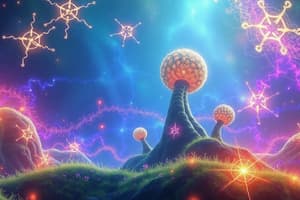Podcast
Questions and Answers
Mendelian genetics describes patterns of inheritance of traits following Mendel's ______.
Mendelian genetics describes patterns of inheritance of traits following Mendel's ______.
laws
Ecology is the study of the relationships between organisms and their ______.
Ecology is the study of the relationships between organisms and their ______.
environment
Natural selection is a key mechanism of ______, where organisms better adapted to their environment are more likely to survive.
Natural selection is a key mechanism of ______, where organisms better adapted to their environment are more likely to survive.
evolution
Biomes are large-scale ecosystems characterized by specific climate and ______ types.
Biomes are large-scale ecosystems characterized by specific climate and ______ types.
Speciation is the process by which new ______ arise.
Speciation is the process by which new ______ arise.
Biology is the scientific study of ______ and living organisms.
Biology is the scientific study of ______ and living organisms.
Prokaryotic cells lack a nucleus and membrane-bound ______.
Prokaryotic cells lack a nucleus and membrane-bound ______.
The ______ is the fundamental unit of life.
The ______ is the fundamental unit of life.
______ are groups of organisms of the same species in a given area.
______ are groups of organisms of the same species in a given area.
Mutations are changes in ______ sequence that can lead to variations in traits.
Mutations are changes in ______ sequence that can lead to variations in traits.
The ______ is the global sum of all ecosystems.
The ______ is the global sum of all ecosystems.
The study of genes and heredity falls under the field of ______.
The study of genes and heredity falls under the field of ______.
Ribosomes are key organelles responsible for ______ synthesis.
Ribosomes are key organelles responsible for ______ synthesis.
Flashcards
Biology
Biology
The scientific study of life and living organisms.
Prokaryotic Cell
Prokaryotic Cell
A cell lacking a nucleus and membrane-bound organelles.
Eukaryotic Cell
Eukaryotic Cell
A cell with a nucleus and membrane-bound organelles.
Organelle
Organelle
Signup and view all the flashcards
Mitochondria
Mitochondria
Signup and view all the flashcards
Ribosomes
Ribosomes
Signup and view all the flashcards
Cell Membrane
Cell Membrane
Signup and view all the flashcards
Gene
Gene
Signup and view all the flashcards
DNA
DNA
Signup and view all the flashcards
Levels of Biological Organization
Levels of Biological Organization
Signup and view all the flashcards
Molecule
Molecule
Signup and view all the flashcards
Ecosystem
Ecosystem
Signup and view all the flashcards
Biosphere
Biosphere
Signup and view all the flashcards
Mendelian Genetics
Mendelian Genetics
Signup and view all the flashcards
Ecology
Ecology
Signup and view all the flashcards
Ecosystem
Ecosystem
Signup and view all the flashcards
Energy Flow
Energy Flow
Signup and view all the flashcards
Nutrient Cycling
Nutrient Cycling
Signup and view all the flashcards
Population Dynamics
Population Dynamics
Signup and view all the flashcards
Symbiotic Relationships
Symbiotic Relationships
Signup and view all the flashcards
Biomes
Biomes
Signup and view all the flashcards
Evolution
Evolution
Signup and view all the flashcards
Natural Selection
Natural Selection
Signup and view all the flashcards
Genetic Drift
Genetic Drift
Signup and view all the flashcards
Common Ancestry
Common Ancestry
Signup and view all the flashcards
Speciation
Speciation
Signup and view all the flashcards
Study Notes
Introduction to Biology
- Biology is the scientific study of life and living organisms, including their structure, function, growth, evolution, distribution, and taxonomy.
- It's a broad field encompassing various specializations like botany (plants), zoology (animals), microbiology (microorganisms).
- Key aspects of biology include studying cells, genetics, ecology, evolution, and the interactions between organisms and their environment.
- Biology utilizes scientific methods, observation, experimentation, and analysis to understand life processes.
Levels of Biological Organization
- Biological systems are organized in hierarchical levels, from the smallest (molecules) to the largest (biosphere).
- Atoms: The fundamental building blocks of matter.
- Molecules: Groups of atoms bonded together, forming larger structures (e.g., proteins, DNA).
- Cells: Basic units of life, capable of reproduction and carrying out metabolic processes.
- Tissues: Groups of cells with a similar structure and function.
- Organs: Structures composed of different tissues performing specific tasks.
- Organ systems: Groups of organs working together to achieve a common goal.
- Organisms: Individual living entities.
- Populations: Groups of organisms of the same species in a given area.
- Communities: Multiple interacting populations in an area.
- Ecosystems: Communities of organisms and their physical environment.
- Biosphere: The global sum of all ecosystems.
Cell Structure and Function
- Cells are the fundamental units of life.
- Prokaryotic cells (bacteria, archaea) lack a nucleus and membrane-bound organelles.
- Eukaryotic cells (plants, animals, fungi, protists) have a nucleus and membrane-bound organelles.
- Key organelles include mitochondria (energy production), ribosomes (protein synthesis), endoplasmic reticulum (protein synthesis and modification), Golgi apparatus (processing and packaging proteins), lysosomes (digestion), and the nucleus (containing DNA).
- Cell membranes regulate what enters and exits the cell.
Genetics
- Genetics is the study of genes, heredity, and variation in organisms.
- Genes are units of heredity, composed of DNA.
- DNA carries the genetic information that dictates the traits of an organism.
- DNA replication ensures that genetic information is passed on during cell division.
- Transcription and translation convert DNA information into proteins.
- Mutations are changes in DNA sequence that can lead to variations in traits.
- Mendelian genetics describes patterns of inheritance of traits following Mendel's laws.
Ecology
- Ecology is the study of the relationships between organisms and their environment.
- Ecosystems involve interactions between organisms and their physical environment (e.g., climate, soil).
- Key ecological concepts include energy flow, nutrient cycling, and population dynamics.
- Symbiotic relationships such as mutualism, commensalism, and parasitism are examples of relationships between different species.
- Biomes are large-scale ecosystems characterized by specific climate and vegetation types.
Evolution
- Evolution is the change in the heritable characteristics of biological populations over successive generations.
- Natural selection is a key mechanism of evolution, where organisms better adapted to their environment are more likely to survive and reproduce.
- Genetic drift is a random change in allele frequencies in a population.
- Common ancestry is a shared evolutionary history that links all life forms on Earth.
- Speciation is the process by which new species arise.
Studying That Suits You
Use AI to generate personalized quizzes and flashcards to suit your learning preferences.




